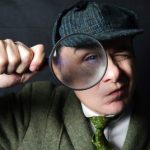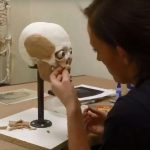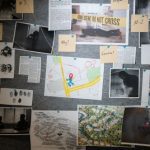 Animals
Animals  Animals
Animals  Weird Stuff
Weird Stuff 10 Weird Things People Used to Do at New Year’s
 Our World
Our World 10 Archaeological Discoveries of 2025 That Refined History
 Weird Stuff
Weird Stuff 10 Fascinating Facts You Might Not Know About Snow
 Miscellaneous
Miscellaneous Top 10 Things Crypto Was Supposed to Change & What Actually Did
 History
History 10 Huge Historical Events That Happened on Christmas Eve
 Music
Music 10 Surprising Origin Stories of Your Favorite Holiday Songs
 History
History 10 Less Than Jolly Events That Occurred on December 25
 Weird Stuff
Weird Stuff 10 Funny Ways That Researchers Overthink Christmas
 Politics
Politics 10 Political Scandals That Sent Crowds Into the Streets
 Animals
Animals 10 Species That Refused to Go Extinct
 Weird Stuff
Weird Stuff 10 Weird Things People Used to Do at New Year’s
 Our World
Our World 10 Archaeological Discoveries of 2025 That Refined History
Who's Behind Listverse?

Jamie Frater
Head Editor
Jamie founded Listverse due to an insatiable desire to share fascinating, obscure, and bizarre facts. He has been a guest speaker on numerous national radio and television stations and is a five time published author.
More About Us Weird Stuff
Weird Stuff 10 Fascinating Facts You Might Not Know About Snow
 Miscellaneous
Miscellaneous Top 10 Things Crypto Was Supposed to Change & What Actually Did
 History
History 10 Huge Historical Events That Happened on Christmas Eve
 Music
Music 10 Surprising Origin Stories of Your Favorite Holiday Songs
 History
History 10 Less Than Jolly Events That Occurred on December 25
 Weird Stuff
Weird Stuff 10 Funny Ways That Researchers Overthink Christmas
 Politics
Politics 10 Political Scandals That Sent Crowds Into the Streets
10 Forensic Methods Pioneered by Sherlock Holmes
Modern forensic criminal investigation is indebted to a fictional character who lived more than a hundred years ago. Sherlock Holmes, created by Sir Arthur Conan Doyle, is hailed as the world’s greatest detective for a reason. A case can be made that he is the pioneering spirit behind today’s CSI, having anticipated the methods modern investigators employ even before law enforcement adopted them as standard practice.
Holmes did not originate these methods, but he took the science while it was still in its infancy and applied it to many of his cases. In doing so, he called attention to their importance and hence became a catalyst in their adoption by police forces worldwide. French criminologist Alphonse Bertillon, inventor of the anthropometric system of suspect identification and proponent of the mug shot, requested a medico-legal study of the Holmes stories be made by the faculty of medicine at Lyon, leading to the establishment in 1910 of the first police forensic lab under Dr. Edmond Locard.
In his book Crime’s Nemesis, criminologist Luke S. May writes, “The writings of Conan Doyle have done more than any other one thing to stimulate active interest in the scientific and analytical investigation of crime. All of these men helped introduce a fundamentally new technique in crime detection.” The real credit, of course, belongs to Sir Arthur Conan Doyle.
Related: 10 Faces of the Dead Rebuilt by Forensic Artists
10 Crime Scene Preservation
“Oh, how simple it would all have been had I been here before they came like a herd of buffalo and wallowed all over it.” —”The Boscombe Valley Mystery”
The 19th-century crime scene was a mess. The police had no system to preserve clues from contamination. The coroner was the official in charge of murder investigations, and he usually didn’t attach much importance to physical evidence, though it was not totally ignored. He was more interested in interviewing potential eyewitnesses to the crime to uncover a “smoking gun” than analyzing the clues. The coroner was a medical man, not a detective.
This resulted in crime scenes being compromised. The body might be moved before the coroner arrived to examine it, taken to the morgue, or laid out in a house or even a pub. Crowds of curious onlookers were allowed to trample the scene, with police and bloodhounds coming and going.
By the time of the Jack the Ripper murders in 1888, police had at least learned to put an inspector in charge, cordon off the scene, and look for footprints and blood trails. But their methods still left much to be desired. In fact, the doctor did not even notice Mary Ann Nichols, the first victim, had been disemboweled until he was informed by the mortuary. The police themselves erased a message written in chalk referencing Jews that might have been their only real lead because it might trigger anti-Semitic riots.
The quote above expresses Holmes’s exasperation at such incompetence. His cases taught future investigators the importance of the seemingly trivial, most minute piece of physical evidence, which must be preserved with utmost care. In the Boscombe Valley case, Holmes’s analysis of cigar ash he found at the scene led him to the culprit.[1]
9 Microscopy
“As he spoke, he whipped a tape measure and a large round magnifying glass from his pocket. With these two implements, he trotted noiselessly about the room, sometimes stopping, occasionally kneeling, and once lying flat upon his face…” —A Study in Scarlet
With Holmes, something seemingly inconsequential, such as dust or soil particles, could tell a story. Examining such minutiae required more than the naked eye. Magnifying glasses had been around before Holmes, but there is no record of them being used in investigative fieldwork. Holmes was the first to use it in fiction, and preeminent forensic expert Sir Sydney Smith of the University of Edinburgh credits Holmes with the idea, fictional or otherwise.
Holmes also used a microscope to examine trace evidence. Though not specified in the stories, Holmes must have used a 10-power silver and chrome magnifying glass and a brass tripod base monocular optical microscope, probably manufactured by Powell & Lealand, the most precise available in Victorian times. These optical instruments would be far outstripped by the power and sophistication of the equipment in present-day crime labs, but the honor of introducing them to detective work belongs to Holmes.[2]
8 Cryptography
“I am fairly familiar with all forms of secret writings, and am myself the author of a trifling monograph on the subject, in which I analyze one hundred and sixty separate ciphers…” —”The Adventure of the Dancing Men”
Ciphers and codes had been in use for thousands of years in war and diplomacy. But even today, most investigators believe ciphers are rarely encountered in criminal cases and that specialized training in cryptography is not worth the effort. However, with the rise of criminal groups like drug cartels and smuggling rings that use codes to communicate, cryptography is a valuable tool in the investigator’s arsenal. Lone wolves like the Unabomber Ted Kaczynski and the Zodiac killer wrote in codes, highlighting the necessity of some police training in basic cryptography.
In “The Adventure of the Dancing Men,” Holmes uses his knowledge of ciphers to solve the case of a lady receiving mysterious stick figure drawings of dancing men. Realizing that the figures were a simple substitution cipher, Holmes was able to decipher the message, anticipate the danger to the woman, and eventually save her.
Most codes in criminal cases are as simple as this, but some are not. Today, the FBI Lab’s Racketeering Records Analysis Unit (RRAU) provides training in cryptanalysis.[3]
7 Ballistics
“The wounds upon the dead man was, as I was able to determine with absolute confidence, fired from a revolver at the distance of something over four yards. There was no powder-blackening on the clothes. Evidently, therefore, Alec Cunningham had lied when he said that the two men were struggling when the shot was fired.” —”The Adventure of the Reigate Squire”
Aside from bullet comparison, ballistics takes into account bullet trajectory, the path, and the distance of the projectile from shooter to target. This is why, in modern CSI, we see detectives marking the location of ejected cartridge casings to establish the position of the shooter. The technique of using strings or lasers to follow the path of the bullet and mathematical formulas to calculate the physics of its movement are improvements in the science since Holmes’s time.
This story, published in 1893, also emphasizes the importance of gunshot residue as evidence five years before the first technical discussion of powder marks appeared in France entitled “La Determination de La Distance a Laguelle un Coup de Den a e’te Tire” (“Determination of the distance at which a shot has been discharged from a firearm”).[4]
6 Handwriting Analysis and Fingerprints
“There is something common between these hands. They belong to men who are blood relatives. It may be most obvious to you in the Greek e’s, but to me, there are several other points that indicate the same thing. I have no doubt at all that a family mannerism can be traced in these two specimens of writing.” —”The Adventure of the Reigate Squire”
Handwriting analysis was known as early as the 3rd century in the Roman world. From its elementary beginnings, it would grow in knowledge and sophistication so that in 1887, it was acknowledged by the Ohio Supreme Court as an important means of identification. However, it was not comprehensively nor systematically used in crime investigation. “The Reigate Squire” has Holmes catching a killer by means of handwriting seven years before a real-life murderer was convicted on the basis of testimony by handwriting experts. Forensic handwriting analysis really took off in the 1930s with the kidnapping of Charles Lindbergh’s baby.
Like handwriting, fingerprints were used as a method of identification centuries before Holmes. It was Mark Twain who actually wrote the first fictional story of a murderer caught by fingerprint evidence in 1883. Doyle’s first reference to fingerprints appears in The Sign of Four (1890). The idea of forensic fingerprint analysis was already in the air, but it had yet to catch fire. The first recorded real-world case solved via fingerprints was in Argentina in 1892. Scotland Yard only began using a rudimentary fingerprint system in 1894, and it was not until 1901 that it became standard practice.[5]
5 Typewriter Analysis
“It is a curious thing,” remarked Holmes, “that a typewriter has really quite as much individuality as a man’s handwriting. Unless they are quite new, no two of them write exactly alike. Some letters get more worn than others, and some wear only on one side…” —”A Case of Identity”
The typewriter was a relatively new technology at the time of Sherlock Holmes, having been around for only about 20 years. As far as can be ascertained, “A Case of Identity,” finished by Doyle in 1891, is the first reference to analyzing questioned documents written by typewriter. His premise is quite sound, and nobody knows how Doyle came upon his data, as the earliest non-fictional written discussion of typewriter identification was in 1894 by William Hagan.
Since then, technology has advanced, and today, forensic document analysis takes into consideration printers and photocopiers. Still, the same principle laid down by Holmes/Doyle and Hagan—that different machines will leave distinguishing marks—still applies.[6]
4 Footprints
“There is no branch of detective science which is so important and so much neglected as the art of tracing footsteps.” —”A Study in Scarlet”
Twenty-nine of the sixty Holmes stories feature footprint evidence. Holmes could unravel the stories they tell wherever they were found, be it on the soil, snow, clay, mud, ash, and even on drapes and doors. Not only footprints but also tire tracks did not escape Holmes’s keen eyes. In “The Solitary Cyclist,” he and Watson follow bike tracks over a muddy moor to lead them to the victim’s body. Carriage tracks figure prominently in “The Greek Interpreter,” horse tracks in “The Adventure of Silver Blaze,” and paw-prints in The Hound of the Baskervilles. Holmes wrote a treatise on preserving a 3D impression of footprints using plaster of Paris, now the standard procedure for investigators.
Footprints were also used by Holmes to deduce the height of a suspect. Taking into account the distance between right and left footmarks (stride length) and the size of the feet can give a pretty good idea of a person’s height and build. Forensic gait, or stride, analysis was only first used in 2001, so Holmes was 130 years ahead of his time. Lately, though, gait analysis has come under critical scrutiny, mainly because a person’s stride is affected by different circumstances. A primer with strict protocols on the use of gait analysis in the courtroom was issued in the UK in 2017.[7]
3 Spectroscopy and Serology
“I have found a re-agent which is precipitated by hemoglobin, and by nothing else… Don’t you see that it gives us an infallible test for blood stains?… The old guaiacum test was very clumsy and uncertain. So is the microscopic examination for blood corpuscles. The latter is valueless if the stains are a few hours old. Now, this appears to act as well whether the blood is old or new. Had this test been invented, there are hundreds of men now walking the earth who would long ago have paid the penalty of their crimes.”—”A Study in Scarlet”
Before spectroscopy, investigators had a hard time distinguishing bloodstains from other stains made by wine, fruit, rust, or mud, to name a few. Holmes’s fictional discovery, in 1887, of an agent that binds specifically with hemoglobin in the blood was indeed a surefire way of isolating bloodstains. It anticipated the real-world discovery by German bacteriologist Paul Uhlenhuth of the precipitin test for human blood in 1900.
Since then, the discovery of blood groupings established the science of serology, the identification of blood, semen, saliva, and other body fluids, which has proved invaluable to modern forensics.[8]
2 Trace Evidence
“It is glue, Watson,” said he… “Those hairs are threads from a tweed coat. The irregular grey masses are dust. There are epithelial scales on the left. Those brown blobs in the centre are undoubtedly glue… Since I ran down that coiner by the zinc and copper fillings in the seam of his cuff, they [Scotland Yard] have begun to realize the importance of the microscope.” —”The Adventure of Shoscombe Old Place”
The foremost maxim of forensic investigation is the “exchange principle,” first enunciated by Dr. Edmond Locard, which states, “Every contact leaves a trace.” Suspects will always leave a trace of themselves at the crime scene while taking something at the scene—dust, dirt, soil, etc.—back with them.
Long before Dr. Locard founded his crime lab at Lyons in 1910, Holmes understood this principle. Locard wrote, “Sherlock Holmes was the first to realize the importance of dust. I merely copied his methods.” In “The Five Orange Pips,” Holmes deduces where a visitor has been by the clay and chalk mixture adhering to his shoes, a method we now call forensic geology. Holmes was an authority on different types of tobacco ash, having written the monograph “Upon the Distinction Between the Ashes of the Various Tobaccos.”
Modern CSI places paramount importance on collecting trace evidence. The white suits, protective tents, and handling clues like fine china—it is light-years away from the topsy-turvy Victorian crime scene.[9]
1 Profiling
“There emerges a young fellow under thirty, amiable, unambitious, absent-minded, and the possessor of a favourite dog, which I should describe roughly as being larger than a terrier and smaller than a mastiff.” —The Hound of the Baskervilles
The careful inspection of a walking stick gave Sherlock Holmes this description of its owner. This ability bordered on the psychic, but Holmes insisted that it was just the application of logic that allowed him to arrive at his conclusions. In “The Adventure of the Blue Carbuncle,” examination of an old, battered felt hat enabled Holmes to come up with an image of the person it belonged to—a fairly well-off man who had seen a recent decline in fortunes, subsequently becoming an alcoholic, leading to his marital troubles.
Holmes could tell a lot about a person he was seeing for the first time. In “The Red-Headed League,” Jabez Wilson was stunned that Holmes knew “that he has at some time done manual labour, that he takes snuff, that he is a Freemason, that he has been in China, and that he has done a considerable amount of writing lately,” even before he had uttered a proper self-introduction.
Today’s criminal profilers are following in Holmes’s footsteps when they construct a portrait of the suspect by evaluating crime scene clues. The FBI’s profiling program had its beginnings in the 1970s and has since helped in bringing to justice rapists, sexual killers, arsonists, and writers of threatening letters.[10]


